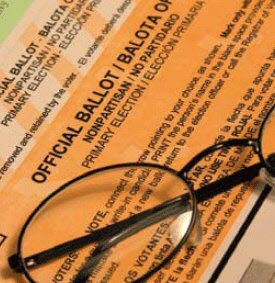 On December 8, the Vanguard ran the Impartial Analysis by City Attorney Harriet Steiner along with the arguments for and against Measure I, the water initiative that will be on the March 5, 2013 ballot.
On December 8, the Vanguard ran the Impartial Analysis by City Attorney Harriet Steiner along with the arguments for and against Measure I, the water initiative that will be on the March 5, 2013 ballot.
The arguments in favor of Measure I were signed by the Davis City Council: Mayor Joe Krovoza, Mayor Pro Tem Dan Wolk, and Councilmembers Rochelle Swanson, Lucas Frerichs, and Brett Lee. The arguments against Measure I were signed by former Councilmembers Sue Greenwald and Michael Harrington, along with Mark Siegler and Michael Bartolic of the WAC, and Pam Nieberg.
The Rebuttal to Arguments Against Measure I was signed by Elaine Roberts-Musser, Chair of the WAC, WAC member and former County Supervisor Helen Thomson, School Board member Susan Lovenburg, Davis Chamber of Commerce President Rose Cholewisnki, and Bob Schneider of the Sierra Club.
The Rebuttal to Arguments For Measure I was signed by Former Mayor and WAC Member Bill Kopper, former School Board member and Director of the Yolo County Taxpayers Association John Munn, Holly Bishop, the Reverend John Pamperin, and Les Portello.
Rebuttal to Arguments Against Measure I
Signed by Elaine Roberts-Musser, Helen Thomson, Susan Lovenburg, Rose Cholewinski, and Bob Schneider
Measure I is necessary to ensure a cleaner, reliable, long-term water supply. The broadly representative citizens on our Water Advisory Committee (WAC) unanimously agreed (10-0) that Davis must add surface water. Our City Council unanimously approved (5-0) this project as the best fiscally and environmentally sustainable solution. Environmentalists, seniors, school leaders, and the business community endorse this path forward.
Benefits
- High quality drinking water and much needed new infrastructure.
- Decrease adverse environmental impacts on waterways and wetlands.
- Reduce reliance on groundwater, helping preserve this irreplaceable asset.
- Save the expense of softeners and replacement of corroded fixtures; eliminate need for reverse osmosis systems.
Cost
- Rates will rise regardless of this project; Measure I ensures investment in a cost-effective, long-lasting solution.
- Reliance on 100% groundwater is shortsighted; deteriorated wells are expensive to continually replace/upgrade.
- Partnership with Woodland reduces costs by over $25 million.
- WAC recommendations have substantially reduced project size/cost.
- Delay brings higher costs; we risk major discharge fines due to low quality water.
Process
- Exhaustive studies of all possible alternatives were conducted; we ruled out becoming a customer of West Sacramento. Ownership/control are important.
- WAC and City Council received extensive input to devise equitable rate system; new rates will rise to a level within the range of northern California cities.
Cost-sharing negotiations between Davis and Woodland will ensure fairness to both communities.
Rebuttal to Arguments For Measure I
Signed by Bill Kopper, John Munn, Holly Bishop, John Pamperin, and Les Portello
The Council argument in favor of the Woodland-Davis Project misrepresents the facts. Davis’ groundwater has not deteriorated in quality or quantity. Our water is becoming softer as the City has added deep wells. Davis meets all current water quality standards, and we should be able to comply with future discharge requirements without surface water. Our groundwater levels are recovering every year, indicating the supply is adequate.
Adding surface water is desirable, but not at any price. Davis’ new sewer treatment plant and the Water Project will cause Davis to have one of the highest utility rates in the State.
This project is not affordable. Many Davis households cannot afford a tripling in water bills. Half of our households make under $60,000 per year. Higher water rates make it unlikely we will pass future school and park tax measures requiring two-thirds of the vote.
Businesses will avoid locating in a community with costly utility fees, and Davis’ property values may fall as home buyers look for communities with lower rates. The Project’s costs will burden future citizens – including our children – with a huge debt load.
Many California municipalities are in deep financial trouble. We need to explore more cost-efficient solutions, such as a regional treatment plant, before risking so much of our community’s future on this extraordinarily expensive Project. Visit www.noonmeasurei.org to learn more.






The rates are not in the ballot
On
Ground water quality:
http://public-works.cityofdavis.org/water/water-quality-information/manganese-advisory
http://public-works.cityofdavis.org/water/water-quality-information/hexavalent-chromium
Alternatives studied:
http://www.wdcwa.com/images/uploadsdoc/111511_tb5_TM_DW_Summary_3.pdf
Water rates:
http://joekrovoza.org/wp-content/uploads/2012/10/CA-NV-2011-Water-Rate-Survey.pdf
Businesses and water:
http://awsassets.panda.org/downloads/lloyds_global_water_scarcity.pdf
Water is todays Gold:
http://www.2030waterresourcesgroup.com/water_full/Charting_Our_Water_Future_Final.pdf
Regarding one of the contaminants in our groundwater in particular, the Office of Environmental Health Hazard Assessment has set a Public Health Goal for hexavalent chromium at 0.02 parts per billion. The California Department of Public Health has two years to set a maximum contaminant level (MCL). It is likely that at least 12 of our 15 wells will require treatment in order to meet the final MCL. The concentration of hexavalent chromium in our groundwater ranges from
The comments box doesn’t seem to like the “less than” symbol. so I will re-post and just say “less than”.
Regarding one of the contaminents in our groundwater in particular, the Office of Environmental Health Hazard Assessment has set a Public Health Goal for hexavalent chromium at 0.02 parts per billion. The California Department of Public Health has two years to set a maximum contaminant level (MCL). It is likely that at least 12 of our 15 wells will require treatment in order to meet the final MCL. The concentration of hexavalent chromium in our groundwater ranges from less than 2 ppb to 40 ppb, and has not been detected in the City’s proposed surface water supply.
As you might recall, hexavalent chromium (also known as “chromium 6”) was also found in drinking water in the southern California town of Hinkley and was brought to popular attention by the involvement of Erin Brockovich.
Michael Harrington said . . .
“The rates are not on the ballot.”
Mike, California Election Code restricts the number of words for a ballot measure to 75 words. Describing a rate structure with 4 customer classes and both Fixed rates and Variable rates in 75 words is an impossibility. Even if you could so describe the rate structure, would you have any of the 75 words left to describe the project?” When we walk into the ballot box (literally or by mail proxy), we have to live with the limits that California Law imposes. That is why we have a Sample Ballot mailed to us each election.
Matt: the information for a Measure J/R vote is specific, and locked down. The CC cannot put anything on the ballot without specific, locked in baseline features, costs, etc. Here, we know almost nothing about the specifics of this project, the specific costs, etc. The CC can do and change anything it wants, once they get Measure I passed. This is basically a blank check, to staff, water consultants, and others with a financial interest in the outcome of the project.
“Davis’ property values may fall as home buyers look for communities with lower rates.”
There are lots of silly arguments in this rebuttal but this one is audacious beyond all others. Davis real estate is the most expensive in the region and the idea that people who can afford a home here will be dissuaded by the marginal cost added to housing expenses by this water project is simply absurd.
I can here the people now complaining about how the $60/month water bill added to their $2000/month mortgage is what forced them to move to Dixon and not the other way around.
We now average about $70/mo for water. This will increase to around 250/mo. We have no grass – just a large Willowbank lot with veggie and flower gardens, and a small fruit-tree orchard. As seniors, we will have to make some choices of where to conserve, what to give up. We do not send anything to the waste-water plant, and we do not get to vote on Measure I, but will oppose it with our efforts.
Willowbank only came into the city water system within the last 10 – 20 years. Your neighborhood has the option of removing itself from the city water system and returning to well water. If I recall, you’d have to drill a couple of wells. I think your advisory committee was exploring that option last year.
Michael Harrington said . . .
[i]”Matt: the information for a Measure J/R vote is specific, and locked down. The CC cannot put anything on the ballot without specific, locked in baseline features, costs, etc.”[/i]
Mike, you are addressing a different subject. The baseline features of a Measure J/R vote can not be described in 75 words either, so they can not be on the ballot. They can be included in the ballot support materials and on the Sample Ballot, but there is no way that they can be included in the actual 75 word ballot language.
pbradyus said . . .
[i]”We now average about $70/mo for water. This will increase to around 250/mo. We have no grass – just a large Willowbank lot with veggie and flower gardens, and a small fruit-tree orchard. As seniors, we will have to make some choices of where to conserve, what to give up. We do not send anything to the waste-water plant, and we do not get to vote on Measure I, but will oppose it with our efforts.”[/i]
Paul, three questions . . . 1) when was the last time you had your irrigation system audited for efficiency? 2) what is the value of the vegetables you grow? Do they pay for the water they consume? 3) What is your water consumption in the Nov/Dec and Jan/Feb billing periods?
Matt:
There seems some confusion on ballot text.
Here’s an example from Prop 37: link ([url]http://ballotpedia.org/wiki/index.php/Text_of_California_Proposition_37_(November_2012)[/url])
As you can see the language of the law is far longer than what ends up on the ballot.
No confusion at all David. The Prop 37 text that appeared on the Ballot was 68 words long, and read as follows:
[i]”Requires labeling of food sold to consumers made from plants or animals with genetic material changed in specified ways. Prohibits marketing such food, or other processed food, as “natural.” Provides exemptions. Fiscal Impact: Increased annual state costs from a few hundred thousand dollars to over $1 million to regulate the labeling of genetically engineered foods. Additional, but likely not significant, governmental costs to address violations under the measure.”[/i]